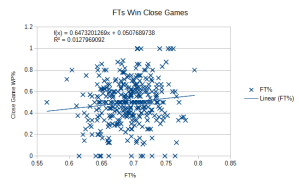Obviously I love the metrics, but there's a natural uproar from Maryland fans who feel disrespected by the computer rankings, offering a number of reasons why the Terps are so good in close games. Some of them boil down to little more than the typical "grit arguments", but some are a bit more intriguing. The one that gets mentioned most frequently is probably the Free Throw Postulate. It states, roughly, that Maryland isn't lucky because they have a such a big spread between their FT% (one of the best in the country) and their opponents' (one of the the worst). For the most part, the close wins this year were Maryland staving off a furious comeback by taking care of the ball and getting theirs at the foul line. To that end I looked at some data from teamrankings.com, comparing FT% and winning% in close games, where "close" is defined as final margin of < 5. Then I graphed it. Here's what that graph looked like for the 351 DI teams this year:
[caption id="attachment_335" align="alignnone" width="625"]
 source: teamrankings.com[/caption]
source: teamrankings.com[/caption]So there's a slight positive relationship, not a strong correlation, but the trend line says that the worst foul shooting team wins 40% of its close games and the best foul shooting team wins 60%. That's one game above the 5-5 median for a team on the far right hand portion of the graph.
The common misconception is that the Terrapins are ranked low in the computers because they're being penalized for the luck of winning close games. That's not really true. When Maryland beat Michigan State 68-66 earlier this year in East Lansing, it was probably lucky to escape from the Breslin Center with a win, but the computers didn't really care. Their algorithms would say that regardless of whether you flipped that score, Maryland had played a good game and would be "rewarded" by the computers.
Conversely, it doesn't really matter that the Terps were on the right side of close games against Penn State or Northwestern. It's obviously better to have won those games for any number of reasons, but the computers downgraded Maryland because they played so many close games against inferior competition, even going back to the beginning of the season when they struggled with USC-Upstate and couldn't put away Monmouth. Top 10 or 15 teams might occasionally play down to their competition, but struggling every time out against the dregs of the conference means is a good sign a team's record is inflated.
Bottom line: The Terps are good, but there's good reason not to believe the record at face value.

